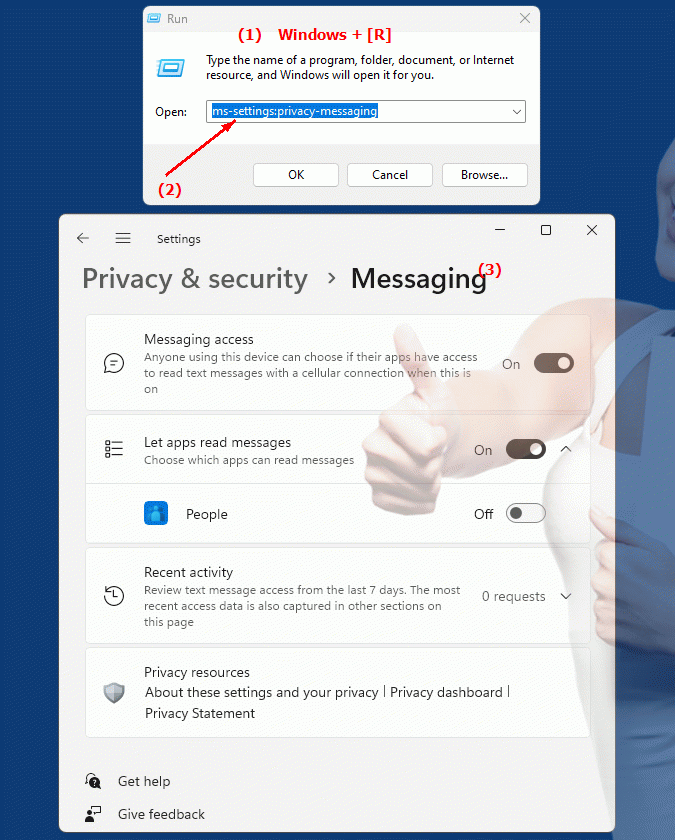The "ms-settings:privacy-messaging" URI in Windows 10 und 11 leads to the privacy settings for messaging applications.
This feature allows users to control which apps and services can access their messages, as well as manage access to messaging data. Access to messaging data is important for many applications to enable features like notifications and synchronization, but can also raise privacy concerns.
1. ms-settings:privacy-messaging
2. Availability under Windows
3. Other useful commands in the Windows settings
1. The Command ms-settings:privacy-messaging
1. Press Windows R on your keyboard.2. Simply execute the following command: ms-settings:privacy-messaging
(This command can also be used as a desktop shortcut.)
3. You can complete the operation by pressing OK or by pressing [Enter].
(... see Image-1 Point 1 to 3)
You now have access to the settings described in your Windows 10, 11 or 12.
This solves the following questions and problems.

1b. This solves the following questions and problems.
How does the ability to allow or deny messages relate to privacy for users?What role does managing access to messaging data play in application usage?
What significance does access to messaging data have for the operation of various apps, especially in relation to functionalities such as notifications and data protection?
Where can I find privacy settings for messaging apps in Windows?
What options does the user have to control the access rights of apps to their messaging data?
How can you ensure that only authorized applications can access the messaging?
How can users ensure their privacy when using messaging applications?
2. This feature is available starting with the respective build numbers in Windows 10, 11 and 12.
Availability in Windows versions
1.Windows10:
- Availability:
The "ms-settings:privacy-messaging" URI is available in Windows 10. This version of Windows allows users to control and manage access to messaging data by apps. These settings provide central management for privacy options related to messaging applications.
- Build number:
The URI is available starting with Windows 10 version 1809 (October 2018 Update). This version introduced enhanced privacy settings that allow granular control over access to messaging data. The specific build number that supports this feature is build 17763 and later.
2.Windows11:
- Availability:
In Windows 11, the "ms-settings:privacy-messaging" URI is also available. Windows 11 provides an improved user interface for managing privacy settings, including controlling how apps access messaging data.
- Build number:
The URI is available starting with Windows 11 build 22000 and later. This build number includes the initial release of Windows 11 as well as all subsequent builds that support this privacy setting.
3.Windows12:
- Availability:
With Windows 12, expected to be released in 2024, the "ms-settings:privacy-messaging" URI is expected to continue to be available. Windows 12 is expected to retain existing functionality for managing access to messaging data and potentially extend it to provide additional privacy options.
- Build Number:
The exact build number for Windows 12 is not determined at the time of release, but the URI is expected to be supported starting with the first released build number of Windows 12.
Summary
The URI "ms-settings:privacy-messaging" provides direct access to privacy settings for messaging applications. It is available in Windows 10 starting with version 1809 (build 17763 and later) and remains available in Windows 11 starting with build 22000 and later. The feature is also expected to be available in Windows 12 once the first build number of Windows 12 is released.
